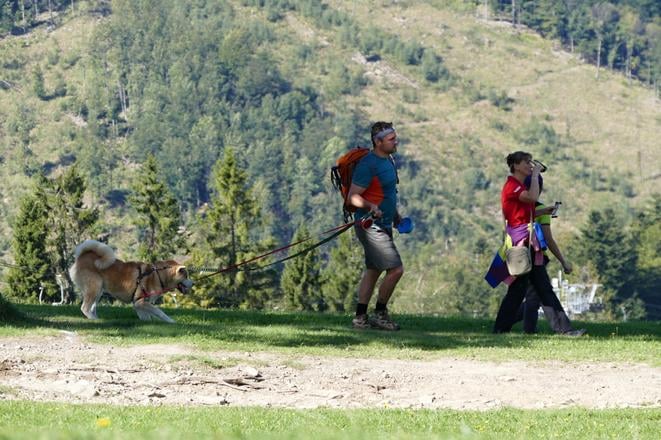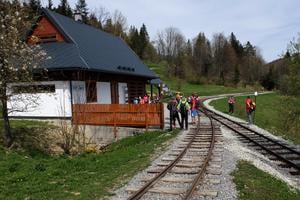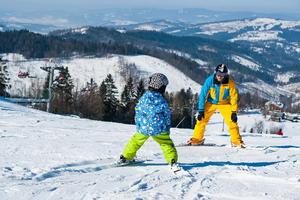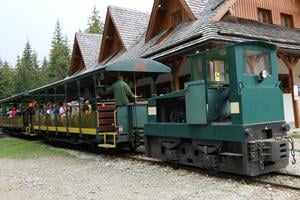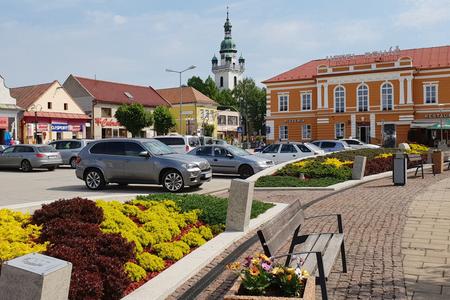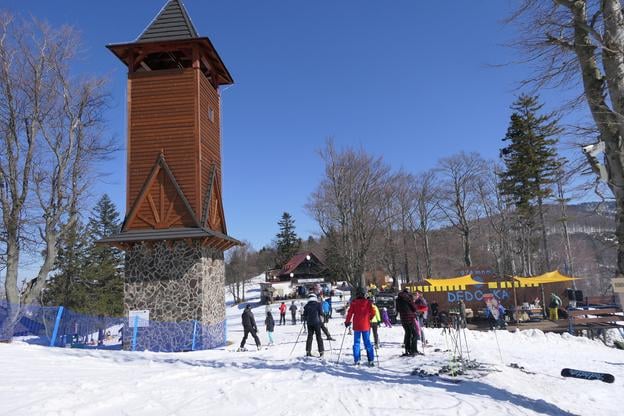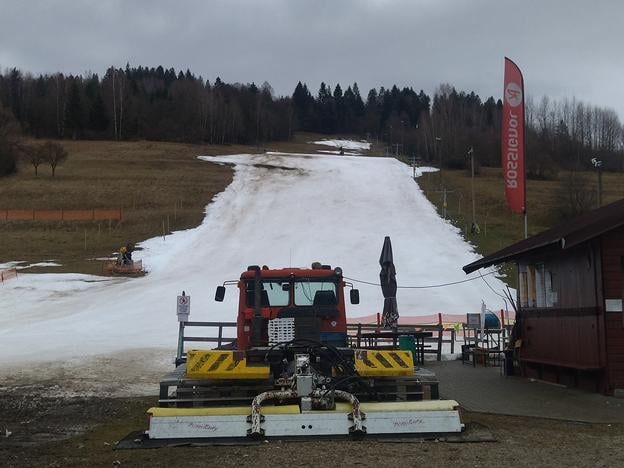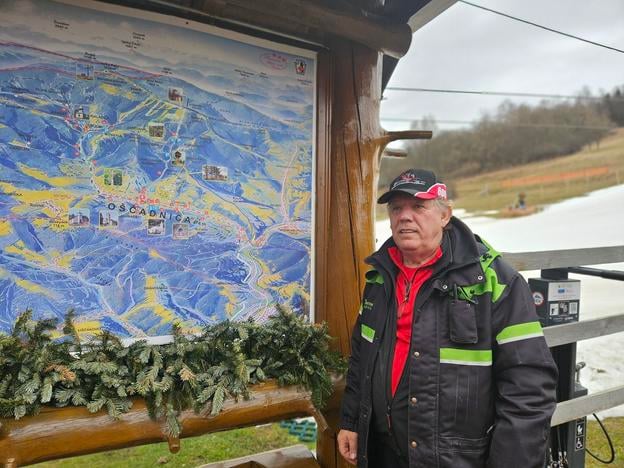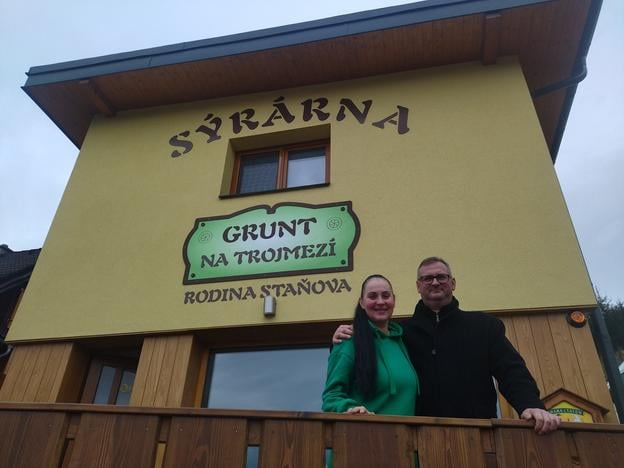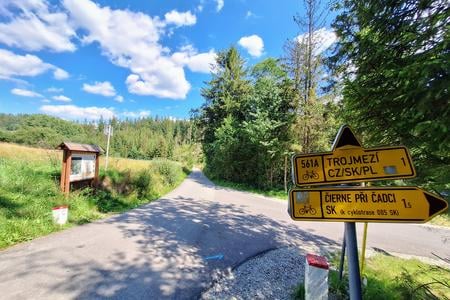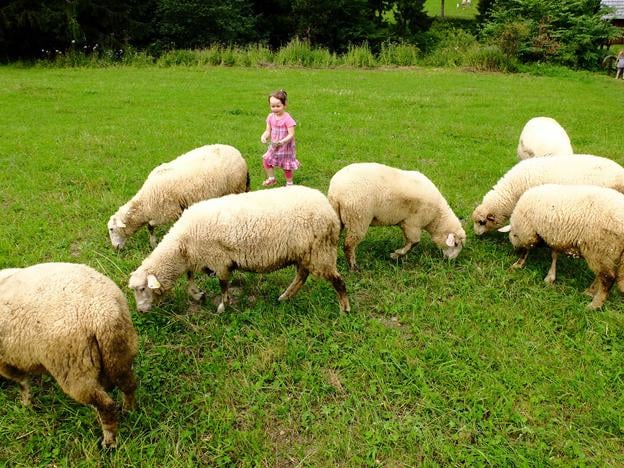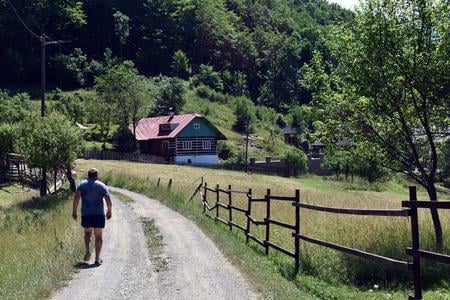Kysuce, a rugged and hilly region in Slovakia’s northwest, is known for its treacherous driving conditions, particularly during peak hours. With no motorway cutting through the landscape, traffic often crawls along the main route to Poland, a vital corridor yet one sorely lacking in infrastructure.
But to truly experience Kysuce, one must step away from the congestion and embrace the slower, winding roads that weave through valleys and past remote settlements. That’s exactly what we set out to do. Setting off in the early evening to avoid the notorious jams, we arrived two and a half hours later in Oščadnica, a sprawling village of 5,700, where the real journey was just beginning.
The magnet for Poles has lost its attraction
Our arrival in the village centre is marked by the church in the square, and we check into the Centrál Guesthouse. The owner, Robert Kopera, greets us personally at the reception desk. He has been involved in the tourism industry for nearly 30 years.
"I started by helping my father in his guesthouse restaurant, but eventually I became independent and have run my own guesthouse for 25 years. It’s essentially a family business—my wife works here, and my daughter and son also lend a hand," Robert Kopera shares.
Cemeteries in Kysuce region
For many foreigners tracing their Slovak heritage, finding the burial sites of their ancestors is a deeply personal journey. To aid in this quest, we have provided maps of the districts we visited, with every cemetery carefully marked. Here you can find cemeteries in Kysuce region.
In the entrance hall of the guesthouse, a few ski boots are lined up, prompting us to ask about the winter season. Kopera admits it had been weak due to a lack of snow. Kysuce once attracted many skiers to the nearby Snowparadise Veľká Rača Oščadnica ski resort, but has lost most of its Polish clientele. Kopera recalls that in the 1990s and early 2000s, Poles made up the majority of his guests. However, after Slovakia adopted the euro in 2009, Polish media warned tourists about rising prices, deterring many visitors. This downturn forced many village guesthouses to close, as Polish tourists had been their primary customers.
"The loss of Polish visitors was disastrous for us. Without savings, we wouldn’t have survived," Kopera says. While some Poles are starting to return to Oščadnica, their numbers remain lower, and they are spending more cautiously.
Over the past decade, Poland has successfully developed its own ski lifts just across the border. Unlike Kysuce, modern ski resorts in Poland now feature an aquapark as a key attraction.
Kopera has been working to attract guests to his newly completed wellness centre, which was finished just before the Covid-19 pandemic. Unfortunately, his investments did not yield returns in the initial years, forcing him to put plans for room renovations on hold.
"An aquapark would be particularly beneficial for us because people enjoy relaxing there, and on bad-weather days, they could spend the entire day using the facilities," says Kopera.
The idea of a water park has sparked discussions among several local entrepreneurs.
We need to lure Poles back
According to Kopera, the primary goal should be to attract more Polish tourists to Kysuce. Their advantage lies in a different mentality compared to Slovaks.
Kopera points out that Poland offers a wide range of activities even outside the peak season. Poles enjoy dining out and spending money, whereas in our region, it can feel rather quiet outside the winter months. He notes that Slovak and Czech tourists often bring their own food and drinks when staying in accommodation.
For Kysuce to become a popular tourist destination, the government or local authorities need to launch a strong marketing campaign—something that, unfortunately, is not happening at the moment.
Kopera believes that a tourist who enjoys mountains and cycling could easily spend a week in Kysuce. He sees the greatest potential in expanding the network of cycling routes.
The decline of skiing affects everyone
During our visit to the ski slope in Oščadnica, a school ski course is just finishing. The slope has very little snow—only a narrow strip surrounded by brown meadows. Despite it being the end of January, the temperature is a surprising 7°C.
Historical names of towns and villages in Kysuce region
Slovakia's territory has been part of different monarchies throughout history, including the Austro-Hungarian Empire from 1867 until 1918. Until 1992, with the exception of the inter-war years 1939-1945 during which the Nazi-aligned Slovak state existed, the territory was a part of Czechoslovakia. As a result of being a part of the Empire, the current names of Slovak municipalities are different than during that era.
Here's a list of the largest municipalities in Kysuce region with their historical names stated in the brackets:
Čadca - Csaca
Čierne - Cserne
Krásno nad Kysucou - Karásznó
Kysucké Nové Mesto - Kiszucaújhely
Nesluša - Neszlény
Oščadnica - Ócsad
Raková - Trencsénrákó
Skalité - Sziklaszoros
Svrčinovec - Fenyvesszoros
Turzovka - Turzófalva
The full list of all Slovak municipalities, including their historical names, can be found at www.geni.sk (in Slovak only).
In recent years, winters have been notably mild, significantly affecting businesses that depend on skiers. One such entrepreneur is Július Gánoczy, owner of the Športcentrum ski resort in Oščadnica and the Gájuz guesthouse.
Július believes the decline in Polish visitors is also due to the deteriorating quality of the ski resort in Veľká Rača. Since its privatisation, ownership of the resort has frequently changed; ticket prices have risen, but the quality of the lifts and services has not improved accordingly.
He understands the situation well, having served as head of the Veľká Rača resort in the 1990s. He left his position due to disagreement over privatising it.
Kopera confirms that the Snowparadise Veľká Rača ski resort is stagnating. "People used to come here to ski, and we provided accommodation. Now, it’s the opposite—we are trying to attract them to go skiing," he adds.
Ganóczy believes the introduction of the euro and higher prices have not deterred Poles from visiting Slovakia. Like Slovakia, Poland is an EU member state, but continues to use its own currency, the zloty. Instead, Ganóczy argues that poorer services in Slovakia, compared to Poland, are the main issue.
"The Poles have made effective use of EU funds; they didn’t misuse them. They built cable cars and improved services such as ski schools, lighting, and ski rentals. Additionally, their prices are approximately 20 percent lower than ours," he explains.
As a result, the number of Polish visitors to Slovakia has declined, despite the fact that they accounted for 90 percent of his clients at the start of the millennium.
Czech visitors have also reduced their numbers since the division of Czechoslovakia and now tend to appear more as hikers than skiers.
According to Ganóczy, Oščadnica has always depended on skiing for its livelihood, but when the skiing season does not go well, it affects everyone in the community. "There used to be private accommodation in every other house, but that is no longer the case," he notes, highlighting the village’s current situation.
He believes that an aquapark will not be a solution for Kysuce, even if one were to be built. Instead, it should complement skiing, which remains the foundation of local businesses.
Cycling is challenging
In the summer, he expects to serve cyclists as the number of cycle paths in Kysuce increases. However, the hilly terrain is not ideal for families, even with the aid of e-bikes. He recommends the cycle path through Bystrická Valley, which runs from Krásno to Vychylovka and was built on a former railway line.
Previously, he offered cart rides on the ski slope during the summer, but wild boars damaged the track, and electric cars in the car park were unpopular. "It wasn’t profitable," he reflects.
Ganóczy, who operates a small ski lift, sees the future of small ski resorts as bleak due to mild winters and a lack of successors. Nearing retirement, he does not pressure his daughters to take over, understanding the hard work involved. "It doesn’t work here like in Austria. When I retire, I’ll probably sell it," he muses.
Trojmedzie can attract crowds
In the morning, we are awakened by the ringing of the church bell. It’s a bit chilly outside, so we have to scrape the ice off the car windows, but we’re excited that the ski lifts are operational. We set off for the village of Čierne.
Following the helpful advice of the owner of the Centrál guesthouse, we avoid the often congested route through Čadca and instead take the quieter road via Skalité. This border village stretches out long and narrow, much like most villages in Kysuce.
After passing through Skalité, we arrive in Čierne and head to the municipal office to meet the mayor. Peter Staňo greets us as he sees off a previous guest. It is only eight in the morning.
The mayor, who previously ran a wood and furniture business, entered public service 15 years ago. He first served two terms in Hrčava, Czech Republic, where he inherited his parents’ house, before becoming mayor of Čierne, Slovakia. "I have dual citizenship, so it’s possible," Staňo explains.
Initially, he thought he could balance being mayor with his business. However, upon realising the bureaucratic demands, he closed the business. "I don’t like paperwork, but I eventually began to enjoy being mayor," he recalls.
He is well aware of the conditions in the three countries whose borders meet near Čierne, allowing him to make effective comparisons. Unfortunately, he believes that tourism in Slovakia is lagging behind that of the Czech Republic and Poland.
"When I served as mayor in Hrčava, we utilised EU funds for two terms, which exceeded the municipality’s budget tenfold. For instance, we built a new low-energy school, as well as pavements, a new road, and lighting along the Trojmedzie area," recalls Staňo, who also owns Grunt, a farm located in the Trojmedzie area on the Czech side of the border.
What was once an area rarely visited due to poor access has gradually transformed into one of the top 10 most visited places in the Moravian-Silesian Region.
Sadly, the potential of this scenic location, which connects three countries, is not being properly harnessed in Slovakia. To illustrate this, Staňo points to the Polish village of Istebna, which offers 1,200 beds for tourists, along with an aquapark and ski lifts. In contrast, Slovakia has only a fraction of such facilities.
The Poles have outpaced us
According to Staňo, the claim that Poles have stopped visiting Slovakia due to higher prices is merely an excuse. "While Poles are price-sensitive, they will pay €4 for a beer. What matters more to them is the quality of service, which we have neglected," he explains. Since service quality in Poland has improved, many Poles now prefer to holiday there.
"Fifteen years ago, Poles lagged behind us in terms of services, but today they are miles ahead," the mayor states. He adds that there is now a noticeable gap between Poland and the Czech Republic on one side, and Slovakia on the other, in terms of the breadth and quality of tourist services.
Kysuce has attractions to offer tourists; it simply needs to improve its services to compete with its neighbours.
The lack of progress can be attributed to the inability of Slovak entrepreneurs to effectively access EU funds. This is not due to their own shortcomings but rather a result of Slovak bureaucracy.
"In Hrčava, I received EU funds for a tractor, a cheese factory, and even for a Slovak shepherd dog, which included a fence with a camera trap to protect my sheep from wolves," Staňo shares. While almost everyone in Hrčava has EU-funded tractors, the same cannot be said for those in Čierne.
Staňo also raises concerns about the proposal to build an aquapark to attract tourists to Kysuce. "We lack basic infrastructure, such as parking and quality accommodation, so an aquapark will be of little benefit without those essentials," he argues.
According to Staňo, tourism is about more than just accommodation, food, and beer. It requires a whole system of interconnected services, including local craftsmen, builders, and pub owners.
Sheep farming should be revitalised
The Kysuce region is facing challenges as traditional agriculture and sheep farming continue to decline. Staňo believes that the future of tourism lies in agrotourism.
To promote this, he has founded events such as the Spring Bull Festival and BačaFest, which showcase traditional shepherding ceremonies, including the practice of driving sheep out to pasture. He drew inspiration from Poland, where sheep numbers have risen from just a few dozen to thousands in recent years.
Staňo also highlights how unnecessarily strict hygiene regulations hinder the sale of cheese from mountain farms to tourists.
"I have a modern cheese factory on the Czech side, but I can’t invite people to buy cheese from me due to hygiene regulations," Staňo explains. Furthermore, selling cheese in a traditional cheese hut is not permitted because it fails to meet hygiene standards—whereas in Poland, such sales are allowed.
According to him, Slovakia has the strictest hygiene regulations among the three countries, yet there is no support for the production of traditional cheese or bryndza (a type of soft sheep’s cheese). "It’s no wonder we have to import bryndza from Poland and milk from Romania," Staňo adds.
Despite his criticism, the mayor remains optimistic. He believes that if municipalities speed up their use of EU funds and enhance their marketing efforts, progress will follow. "We need to attract visitors from across the border because domestic tourists alone will not be enough to sustain us," he emphasises.


